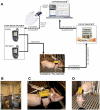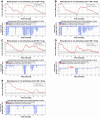A feasibility study of bihormonal closed-loop blood glucose control using dual subcutaneous infusion of insulin and glucagon in ambulatory diabetic swine
- PMID: 20144330
- PMCID: PMC2769971
- DOI: 10.1177/193229680900300428
A feasibility study of bihormonal closed-loop blood glucose control using dual subcutaneous infusion of insulin and glucagon in ambulatory diabetic swine
Abstract
Background: We sought to test the feasibility and efficacy of bihormonal closed-loop blood glucose (BG) control that utilizes subcutaneous (SC) infusion of insulin and glucagon, a model-predictive control algorithm for determining insulin dosing, and a proportional-derivative control algorithm for determining glucagon dosing.
Methods: Thirteen closed-loop experiments (approximately 7-27 h in length) were conducted in six ambulatory diabetic pigs weighing 26-50 kg. In all experiments, venous BG was sampled through a central line in the vena cava. Efficacy was evaluated in terms of the controller's ability to regulate BG in response to large meal disturbances ( approximately 5 g of carbohydrate per kilogram of body mass per meal) based only on regular frequent venous BG sampling and requiring only the subject's weight for initialization.
Results: Closed-loop results demonstrated successful BG regulation to normoglycemic range, with average insulin-to-carbohydrate ratios between approximately 1:20 and 1:40 U/g. The total insulin bolus doses averaged approximately 6 U for a meal containing approximately 6 g per kilogram body mass. Mean BG values in two 24 h experiments were approximately 142 and approximately 155 mg/dl, with the total daily dose (TDD) of insulin being approximately 0.8-1.0 U per kilogram of body mass and the TDD of glucagon being approximately 0.02-0.05 mg. Results also affirmed the efficacy of SC doses of glucagon in staving off episodic hypoglycemia.
Conclusions: We demonstrate the feasibility of bihormonal closed-loop BG regulation using a control system that employs SC infusion of insulin and glucagon as governed by an algorithm that reacts only to BG without any feed-forward information regarding carbohydrate consumption or physical activity. As such, this study can reasonably be regarded as the first practical implementation of an artificial endocrine pancreas that has a hormonally derived counterregulatory capability.
Copyright 2009 Diabetes Technology Society.
Figures







Similar articles
-
A bihormonal closed-loop artificial pancreas for type 1 diabetes.Sci Transl Med. 2010 Apr 14;2(27):27ra27. doi: 10.1126/scitranslmed.3000619. Sci Transl Med. 2010. PMID: 20393188 Free PMC article. Clinical Trial.
-
Efficacy determinants of subcutaneous microdose glucagon during closed-loop control.J Diabetes Sci Technol. 2010 Nov 1;4(6):1288-304. doi: 10.1177/193229681000400602. J Diabetes Sci Technol. 2010. PMID: 21129323 Free PMC article. Clinical Trial.
-
Closed-loop artificial pancreas using subcutaneous glucose sensing and insulin delivery and a model predictive control algorithm: the Virginia experience.J Diabetes Sci Technol. 2009 Sep 1;3(5):1031-8. doi: 10.1177/193229680900300506. J Diabetes Sci Technol. 2009. PMID: 20144416 Free PMC article.
-
Safe glycemic management during closed-loop treatment of type 1 diabetes: the role of glucagon, use of multiple sensors, and compensation for stress hyperglycemia.J Diabetes Sci Technol. 2011 Nov 1;5(6):1373-80. doi: 10.1177/193229681100500608. J Diabetes Sci Technol. 2011. PMID: 22226254 Free PMC article. Review.
-
Data-driven modeling and prediction of blood glucose dynamics: Machine learning applications in type 1 diabetes.Artif Intell Med. 2019 Jul;98:109-134. doi: 10.1016/j.artmed.2019.07.007. Epub 2019 Jul 26. Artif Intell Med. 2019. PMID: 31383477 Review.
Cited by
-
Continuous glucose monitoring awaits its "killer app".J Diabetes Sci Technol. 2008 May;2(3):490-4. doi: 10.1177/193229680800200321. J Diabetes Sci Technol. 2008. PMID: 19885216 Free PMC article.
-
Stable liquid glucagon formulations for rescue treatment and bi-hormonal closed-loop pancreas.Curr Diab Rep. 2012 Dec;12(6):705-10. doi: 10.1007/s11892-012-0320-5. Curr Diab Rep. 2012. PMID: 22972416 Free PMC article. Review.
-
Feasibility of large experimental animal models in testing novel therapeutic strategies for diabetes.World J Diabetes. 2021 Apr 15;12(4):306-330. doi: 10.4239/wjd.v12.i4.306. World J Diabetes. 2021. PMID: 33889282 Free PMC article. Review.
-
A bihormonal closed-loop artificial pancreas for type 1 diabetes.Sci Transl Med. 2010 Apr 14;2(27):27ra27. doi: 10.1126/scitranslmed.3000619. Sci Transl Med. 2010. PMID: 20393188 Free PMC article. Clinical Trial.
-
Closed-loop insulin delivery: from bench to clinical practice.Nat Rev Endocrinol. 2011 Feb 22;7(7):385-95. doi: 10.1038/nrendo.2011.32. Nat Rev Endocrinol. 2011. PMID: 21343892 Review.
References
-
- Jaremko J, Rorstad O. Advances toward the implantable artificial pancreas for treatment of diabetes. Diabetes Care. 1998;21(3):444–450. - PubMed
-
- The Diabetes Control and Complications Trial Research Group. The effect of intensive treatment of diabetes on the development and progression of long-term complications in insulin dependent diabetes mellitus. N Engl J Med. 1993;329(14):977–986. - PubMed
-
- Nathan DM, Cleary PA, Backlund JY, Genuth SM, Lachin JM, Orchard TJ, Raskin P, Zinman B. The Diabetes Control and Complications Trial/Epidemiology of Diabetes Interventions and Complications (DCCT/EDIC) Study Research Group. Intensive diabetes treatment and cardiovascular disease in patients with type 1 diabetes. N Engl J Med. 2005;353(25):2643–2653. - PMC - PubMed
-
- Renard E. Implantable closed-loop glucose-sensing and insulin delivery: the future for insulin pump therapy. Curr Opin Pharmacol. 2002;2(6):708–716. - PubMed
Publication types
MeSH terms
Substances
LinkOut - more resources
Full Text Sources
Other Literature Sources
Medical
Research Materials

